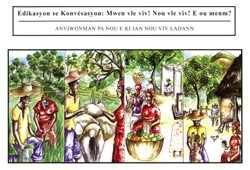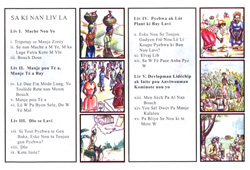“My husband had a garden and a goat came into his garden and he got mad. He cut the head of the goat. So during the program, I showed him the books. I told him, “Cutting the animal is not a good idea. Don’t do that because also when you do that it hurts the owner of the goat. You have to bring it to a mediator.” So this program has been very good for me.”
“There is a person whose husband does a lot of charcoal. She told me, “Though I learned a lot in this program, my husband cuts trees. After I learned in this program, it made me sad to think how many trees we cut. I even cut young ones. I know I must rebuild the land where the trees were cut. For each one I cut, I will plant five.” Look over there. I think she is doing it. She came to a level of awareness.”
“My husband used to burn the land. Since I’ve been in the program, he doesn’t do it anymore. In the afternoon when we are not busy, I share the stories with him and we talk about it. I shared what I learned with others when we are working in the fields. They see that the stories makes sense...like where people thought the person had done magic not realizing that the person took care of the land...”
“I really liked the story about people letting their animals go in other people’s gardens. I hadn’t really thought about that before. After reading the story, I really became more careful about where I tie my animals up. To resolve this problem we need to talk to each other to understand that a deficit for one is a deficit for the other.”
“This program brought a lot of confidence. When a person is selling a lot of plantains, she cleans the whole place around where she is selling but she didn’t do that before. Now we do it ourselves. Before people would think, ‘she doesn’t clean up. So why should I clean up?’ But because they’ve been in the program now, their awareness has been raised and they clean up and now they talk to others to clean up...they tell people, “You can’t wash sugar. So you have to cover your sugar.” They give the example from the story where the child got sick from the dust and microbes in the sugar.”
“The idea of the environment, it has never been presented to us in a program where they show you what to do and what not to do. We gave a lot of value to this program. I learned about composting. I didn’t know about this before...so I tried it. I cannot say about the final result because we just planted, but the first sprouts are very promising. ”
Haiti Environment-Agricultural Education Project
ANVIWONMAN PA NOU E KI JAN NOU VIV LADANN
Our Environment and How We Live In It
EDIKASYON SE YON KONVESASYON! MWEN VLE VIV! NOU VLE VIV! E OU MENM!
Education is a Conversation: We Want to Live! I Want to Live! Don’t You?


The Haitian environmental project includes stories about market hygiene and sanitation, jealousy towards successful market women and farmers, poverty and tree cutting, disputes over tree ownership and cutting, planting trees, water rights, free animal grazing, flooding, burning land, unclean drinking water, disputes over land rental and ownership rights, insect pests and natural pesticides, the water cycle, how to grow beans, the water cycle, how to make a barrier to protect the land from erosion, how to make a natural pesticide, encouraging youth to improve the rural environment and motivating community activism. This program was sponsored by Fonkoze, Beyond Borders and Limye Lavi and is copyrighted by these organizations together with Kathleen Cash.
